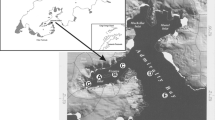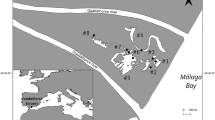Abstract
The distribution of three phytoplanktonic size fractions was studied in an eutrophic lake. Size fractionation experiments were performed using cell enumeration by inverted microscopy and chlorophyll a estimation. The results were also compared with the ATP content in the analysed algal fractions.
The (1–12 µm) fraction represented only on average 5 % of the total biomass, when estimated by the cell enumeration method, but made up 26 % of the total chlorophyll a and 33 % of the total ATP. This discrepancy confirms that cell enumeration with an inverted microscope seriously underestimates the ‘nanoplankton’ biomass.
The (12–45 µm) fraction made up to 50% of the total biomass regardless the method of analysis used. The chlorophyll a and biovolume estimation in this fraction were positively correlated.
The contribution of algal species with large cell size (45–160 µm) to the total algal biomass was higher (39%) when based on their biovolume estimation than when on the chlorophyll a (27%). The low ATP contribution of this fraction (17%) may be attributable to high percentage of dead cells.
Similar content being viewed by others
References
Aleya, L., 1987. Dynamique des populations phytoplanctoniques du lac d'Aydat, Puy-de-Dôme (France). Biomasse et activité métabolique de diverses fractions de taille. Thèse 3ème cycle, Univ. Clermont II, 216 pp.
Aleya, L., J. Devaux, H. El Magouri, O. Marvalin & C. Amblard, 1988. Usefulness of the use of several methods for the estimation of phytoplankton biomass. Eur. J. Protistology, 23: 334–342.
Amblard, C., 1983. Intérês du dosage de l'ensemble des nucléotides adényliques pour l'estimation de la biomasse des populations phytoplanctoniques lacustres (lac Pavin, France). J. Plankton Res., 5: 723–738.
Amblard, C., 1986. Les nucléotides adényliques: intérêts pour l'étude de la biomasse, de l'activité métabolique et de la structure des peuplements phytoplanctoniques lacustres. Thèse Doct. Etat, Univ. Clermpnt 11, 317 pp.
Amblard, C., 1987. Les successions phytoplanctoniques en milieu lacustre. L'Année Biologique 26: 1–34.
Bailey-Watts, A. E., 1986. Seasonal variation in size spectra of phytoplankton assemblages in Loch Leven, Scotland. Hydrobiologia. 138: 25–42.
Banse, K., 1976. Rate of growth, respiration and photosynthesis of unicellular algae as related to cell size a review. J. Phycol. 12: 135–140.
Bergquist, A. M., 1985. Effects of herbivory on phytoplankton community composition, size structure and productivity. Phd. D. dissertation, University of Notre Dame.
Bergquist, A. M., S. R. Carpenter & J. C. Latino, 1985. Shifts in phytoplankton size structure and community composition during grazing by contrasting zooplankton assemblages. Limnol. Oceanogr. 30: 1037–1045.
Booth, B. C., J. Lewin & R. E. Norris, 1982. Nanoplankton species predominant in the subarctic Pacific in May and June 1978. Deep Sea Res., 29: 185–200.
Boswell, J. P., W. B. Perry & J. A. Standford, 1980. Analysis of Plankton dynamics in a Southwestern U.S.A. reservoir Using ATP Assays. Int. Rev. Gesamten Hydrobiol. 65 (1): 155–167.
Caron, D. A., 1983. Technique for enumeration of heterotrophic and phototrophic nanoplankton, using epifluorescence microscopy, and comparison with other procedures. Appl. Environ. Microbiol. 46 (2): 491–498.
Davis, P. G. & J. M. Sieburth, 1982. Differentiation of the photosynthetic and heterophic populations of nanoplankters by epifluorescence microscopy. Ann. Inst. Oceanogr. (Paris) 58 (suppl.) 249–259.
Elser, J. J., M. M. Elser & S. R. Carpenter, 1986. Size fractionation of algal chlorophyll, carbon fixation and phosphatase activity: relationship with species-specific size distributions and zooplankton community structure. J. Plankton Res. 8: 365–383.
Eppley, R. W., J. N. Rogers & J. J. Mc Carthy, 1969. Half-saturation constants for uptake of nitrate and ammonium by marine phytoplankton. Limnol. Oceanogr. 23: 1248–1255.
Eppley, R. W. & P. R. Sloan, 1966. Growth rates of marine phytoplankton: correlation with light absorption by cell chlorophyll a. Physiol. Plant;. 19: 47–59.
Findenegg, I., 1965. Relationship between standing crop and primary productivity. Mem. Inst. Ital. Idrobiol. 18, (suppl.): 271–289.
Glowicz, Z. M., 1977. Food size selection and seasonal succession of filter feeding zooplankton in an eutrophic lake. Ekol. pol. 25: 179–225.
Gulati, R. D., 1975. A study on the role of the herbivorous zooplankton community as primary consumers of phytoplankton in Dutch lakes. Verh. int. Ver. Limnol. 19: 1202–1210.
Harris, G. P., 1978. Photosynthesis,productivity and growth: the physiological ecology of phytoplankton. Arch. Hydrobiol. Bech. Ergeb. Limnol., 10: 1–171.
Hewes, C. D. & O. Holm-Hansen, 1983. A method for quantitatively recovering nanoplankton from filters for identification with the microscope: the filter-transfer-freeze (FTF) technique. Limnol. Oceanogr. 28: 389–394.
Hewes, C. D., F. M. H. Reid & Holm-Hansen, 1984. The quantitative analysis of nanoplankton: a study of methods. J. Plankton Res. 6: 601–614.
Höhne, E., B. Nixdorf & M. Drauss, 1982. Seasonal changes in phytoplankton activity in the Saidenbach reservoir and microautoradiography applications. Limnologica. 14 (2): 221–229.
Holm-Hansen, O. & B. R. Booth, 1966. The measurement of adenosine triphosphate in the ocean and its ecological significance. Limnol. Oceanogr. 11: 510–519.
Kalff, J., 1967. Phytoplankton abundance and primary production rates in two arctic ponds. Ecology 48: 558–565.
Kalff, J., 1972. Netplankton and nanoplankton production and biomass in a North temperate zone lake. Limnol. Oceanogr. 17: 712–720.
Karl, D. M. & O. Holm-Hansen, 1978. ATP, ADP and AMP determination in water samples and algal cultures. Handbook of Phycological methods., Physiological and biochemical methods, Cambridge Univ. Press: 198–216.
Laws, E. A., 1975. The importance of respiration losses in controlling the size distribution of marine phytoplankton. Ecology 56: 419–426.
Legendre, L. & W. D. Watt, 1971–1972. On a rapid technic for plankton enumeration. Ann. Inst. Oceanogr. Paris WLVIII: 173–177.
Lohmann, H., 1908. Untersuchungen zur Feststellung des Wollständigen Gehaltes des Meeres an Plankton. Wiss Meeresunters, Abt. Kiel N.F. 10: 132–170.
Lund, J. W. G., C. Kipling & D. Le Grenne, 1958. The inverted microscope method of estimating algal numbers and the statistical basis of estimations by counting. Hydrobiologia. 11(2): 143–170.
Lynch, M. & J. Shapiro, 1981. Predation, enrichment and phytoplankton community structure. Limnol. Oceanogr. 26: 86–102.
Mac Cauley, E. & J. Kalff, 1980. Emperical relationships between phytoplankton and zooplankton biomass in lakes. Can. J. Fish. aquat. Sci. 38: 458–463.
Mac Carthy, J. J., W. R. Taylor & M. E. Lotfus, 1974. Significance of nanoplankton in the Chesapeake Bay estuary and problems associated with the measurement of nanoplankton productivity. Mar. Biol. 24: 7–16.
Malone, T. C., 1971. The relative importance of nanoplankton and netplankton as primary producers in Tropical Oceanic and neritic phytoplankton communities. Limnol. Oceanogr. 16: 633–639.
Malone, T. C., 1977. Light-saturated photosynthesis by phytoplankton size fractions in the New York Bight, USA. Mar. Biol. 42: 281–292.
Malone, T. C., 1980. Algal size. In Morris, I (ed.). The Physiological Ecology of the phytoplankton. University of California Press, Berlsely: 433–463.
Malone, T. C., M. B. Chervin & D. C. Boardman, 1979. The effects of 22-µm screens on size-frequency distributions of suspended particles and biomass estimates of phytoplankton size fractions. Limnol. Oceanogr. 24: 956–960.
Margalef, R., 1977. Ecologia. Ed. Omega, Barcelona: 951 pp.
Marvalin, O., 1988. Abondance, biomasse, activité et relations trophiques des communautés bactériennes hétérotrophes du lac d'Aydat. Contribution à l'étude des systémes aquatiques. Thése Univ. Clermont II, 120 pp.
Mel'Nikov, N. S., 1976. Comparison of the magnitude of the microplankton biomass determined from ATP and by direct microscopy. Oceanology 16: 181–183.
Millerioux, G., 1976. Contribution à l'étude du lac d'Aydat. Doct. 3éme Cycle, Univ. de Clermont. 107 pp.
Munawar, M. & I. F. Munawar, 1986. The seasonality of phytoplankton in the North American Great Lakes, a comparative synthesis. Hydrobiologia 138: 85–115.
Munawar, M., I. F. Munawar, L. R. Culp & G. Dupuis, 1978. Relative importance of nanoplankton in Lake Superior phytoplankton biomass and community metabolism. J. Great Lakes Res. 4: 462–480.
Nixdorf, B., 1985. Photosynthetic activity of dominant algal species in eutrophic shalow lake (Grober Mügelsee, Berlin) Investigated by microautoradiography. Int. Revue ges. Hydrobiol., 70, 2: 237–246.
Odum, E. P., 1969. The strategy of ecosystem development. Science 164: 262–270.
Paasche, E., 1960. On the relationship between primary production and standing crop of phytoplankton. J. Cons. perm. int. Explor. Mer. 26: 33–48.
Paerl, H. W., 1977. Ultraphytoplankton biomass and production in some New Zealand lakes. N.Z.J. Mar. Freshwater Res. 11: 297–305.
Paerl, H. W.,1978. Effectiveness of various counting methods in detecting viable phytoplankton. N.Z.J. Mar. Freshwater Res. 12: 67–72.
Paerl, H. W. & L. A. Mackenzie, 1977. A comparative study of the diurnal carbon fixation patterns of nanoplankton and net plankton. Limnol. Oceanogr. 22: 732–738.
Paerl, H. W. & N. J. Williams, 1976. The relation between adenosine triphosphate and microbial biomass in diverse aquatic ecosystems. Int. Revue ges. Hydrobiol. 61 (5): 659–664.
Pavoni, M., 1963. Die Bedeutung des Nanoplankton. Schweiz. Z. Hydrol. 25: 219–341.
Platt, T. & K. Denman, 1977. Organization in the pelagic ecosystem. Helgolander Meeresunters. 30: 575–581.
Pourriot, R., 1982. Ecologie du plancton des eaux continentales. Collection d'Ecologie n° 16, Masson ed. Paris, 198 pp.
Rai, H., 1982. Primary production of various size fractions of natural phytoplankton communities in a north German lake. Arch. Hydrobiol., 95, 1–4: 395–412.
Reid, F. M. H., 1983. Biomass estimation of components of the marine nanoplankton and picoplankton by the Utermöhl settling technique. J. Plankton Res. 5: 235–252.
Reynolds, C. S., 1984. The ecology of freshwater phytoplankton. Cambridge University Press, Cambridge, 384 pp.
(S.C.O.R.) U.N.E.S.C.O., 1966. Determination of photosynthetic pigments in sea water. S.C.O.R. — U.N.E.S.C.O., 69 pp.
Sheldon, R. W. & W. H. Sutcliffe, 1969. Retention of marine particles by screens and filters. Limnol. Oceanogr. 17: 327–340.
Sieburth, M., V. Smetacek & J. Lenz, 1978. Pelagic ecosystem structure: heterotrophic components of the plankton and their relationship to plankton size-franctions. Limnol. Oceanogr. 23: 1256–1263.
Sinclair, M., E. Keighan & J. Jones, 1979. ATP as a measure of living phytoplankton carbon in estuaries. J. Fish. Res. Bd. Can., 36: 180–186.
Shuter, B. J., 1978. Size dependence of phosphorus and nitrogen subsistence quotas in unicellular organisms. Limnol. Oceanogr. 23: 1248–1255.
Smayda, T. J., 1970. The suspension and sinking of phytoplankton in the sea. Oceanogr. Mar. Biol. Am. Rev. 8: 353–414.
Smith, R. E. H. & J. Kalfl, 1982. Size-dependent phosphorus uptake and cell quota in phytoplankton. J. Phycol. 18: 275–284.
Smith, R. E. H. & J. Kalff, 1983. Competition for phosphorus among co-occuring freshwater phytoplankton. Limnol. Oceanogr. 28: 448–464.
Steele, J. H. & B. W. Frost, 1977. The structure of plankton communities. Phil. Trans. R. Soc. Lond. B 280: 485–534.
Strehler, B. L. & Totter, J. R., 1952. Firefly luminescence in the study of energy transfer mechanisms. I. Substrate and enzyme determination. Arch. Biochem. Biophys. 40: 28–41.
Taguchi, S., 1976. Relationship between photosynthesis and cell size of marine diatoms. J. Physiol. 12: 185–189.
Takahashi, M. & P. K. Bienfang, 1983. Size structure of phytoplankton biomass and photosynthesis in subtropical Hawaiian waters. Mar. Biol., 76 (2): 203–211.
Takamura, N., T. Iwakuma & Y. Masayuki, 1986. Photosynthesis of size-fractionated phytoplankton population in hypertrophic lake Kasumigaura. Japan. Arch. Hydrobiol. 108: 235–257.
Uterrmohl, H., 1958. Zur Vervollkommung der quantitative Phytoplankton-Methodik. Mitt. intern. Ver. Limnol. 9: 1–38.
Willen, T., 1959. The phytoplankton of Gorwalm, a bay of lake Malaren. Oikos 10: 241–274.
Author information
Authors and Affiliations
Rights and permissions
About this article
Cite this article
Aleya, L., Amblard, C. Importance quantitative de différentes classes de taille phytoplanctoniques en milieu lacustre eutrophe. Hydrobiologia 183, 97–113 (1989). https://doi.org/10.1007/BF00018715
Received:
Revised:
Accepted:
Issue Date:
DOI: https://doi.org/10.1007/BF00018715




